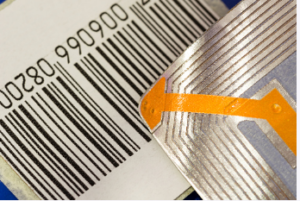Ramp RFID technology can be an invaluable asset to businesses that seek to optimise their supply chain processes, from identification and data capture to work time reduction and increased productivity.
 Retail brands also benefit from the visibility of inventory within their stores, eliminating the need for staff members to spend long hours counting stock, saving time, money, and labour costs.
Retail brands also benefit from the visibility of inventory within their stores, eliminating the need for staff members to spend long hours counting stock, saving time, money, and labour costs.
Cost
RFID may seem costly initially, but investing in this system will pay dividends in your business in many ways. By optimising production processes more efficiently and saving on labour and material costs, your production efficiency increases, and profit margins expand. At the same time, sales grow – quickly covering any upfront costs related to implementing a Ramp RFID system.
RFID simplifies managing inventory, leading to improved customer service and sales growth and lessened returns of goods that come back into your company.
The cost of RFID depends on the type of tag being used; passive ones don’t require batteries and can typically be purchased for seven to 15 cents each; active tags that need batteries will cost more, plus RFID systems require various pieces of hardware, networking equipment and software – which may amount to thousands in investments over time.
Security
RFID technology offers several security measures that can help to protect a business, such as encryption, which prevents people from gaining access to the data stored on RFID tags; fraud reduction; theft prevention; as well as helping employees from leaving work documents unattended – an issue which threatens productivity in many offices.
RFID can be an invaluable asset to businesses that rely on inventory control. Retailers who utilise RFID can reduce human error in stock-taking and improve accuracy – driving sales and customer satisfaction while enhancing sales overall. In libraries, RFID provides security against theft.
Alongside the security offered by Ramp RFID systems, companies should adopt information security practices consistent with industry standards. It should include developing an action plan to identify reasonably foreseeable internal and external risks to the information stored, processed or transmitted using their RFID system and then creating mitigation strategies to limit these risks.
Accuracy
Businesses requiring tracking items moving between locations need precise location data to help reduce cost, ease picking/packing speed, and enhance customer satisfaction. RFID systems offer accurate location data that can reduce complexity while speeding up picking/packing, thus improving overall efficiency.
RFID provides valuable insight into store operations by instantly checking in entire shipments, eliminating blind receipts. Furthermore, it reduces cycle count time and automates reordering at safety stock levels to prevent overstocking or sales loss due to shelf shrinkage.
Flexibility
Barcodes cannot store as much data, while RFID tags can hold far more. Companies use this information to track where an item is, improving processes and increasing productivity while providing more accurate customer service – something precious to retailers who sell a wide range of items.
RFID provides businesses with flexible measures that can help increase revenue and improve their bottom line. For example, retailers may find RFID helpful for automating scanning and payment processes to lower transaction costs while increasing customer satisfaction and loyalty.
RFID in the supply chain can help to cut inventory costs by minimising stockouts. When items are tracked, a company or network can plan purchases based on planned sales and reorder before running out, leading to lower purchase, storage and maintenance costs. Furthermore, using pay-per-use business models can form strategic networks between buyers and suppliers.
Productivity
Keeping track of equipment, materials, and other assets can be a challenge for most organisations. Whether it’s a new piece of equipment, components on the production line or inventory shipped to customers, it can be easy to lose track of these valuable items.
With RFID, you can instantly audit the status of any item with a scanning device. It enables you to verify that all required inspections and checks have been completed on an asset before it leaves the warehouse. It helps to keep quality high and fend off shrinkage.
RFID can also help increase productivity in the warehouse by streamlining processes. For example, it can be used to speed up goods receipt, reduce cycle counts and automatically reorder products at safety stock levels. It also helps you avoid downtime when a product is in short supply, so it’s available for use as quickly as possible. It can have a direct impact on your bottom line.